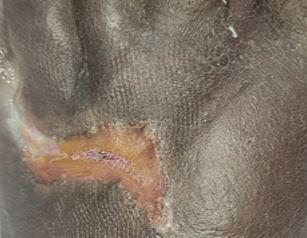A case study of Necrotising Fascitis w.s.r. to Pittaja Dushta Vrana
Keywords:
Necrotising fasciitis, Vrana, Dushta Vrana, Case ReportAbstract
Necrotising fascitis is a spreading inflammation of the skin, deep fascia and soft tissues with extensive destruction, toxaemia commonly due to Streptococcus Pyogens infection. It is common in old age, smoking, diabetes, immunosuppressed individuals. Trauma is the precipitating factor for this disease. It can occur in limbs, lower abdomen, groin, perineum etc. It needs intensive care with appropriate antibiotics and surgical debridement. Vrana is a condition which even after the complete healing, leaves a scar over the area, which stays as long as the person is alive. Vrana which has foul odour, has abnormal colour with profuse discharge, intense pain and takes longer time to heal is said to be Dushta. Acharya has mentioned separate treatment for the management of these Vrana in detail. It is a case report of a 46 year old male patient who presented with chief complaints of pain and swelling over the dorsum of the left foot with foul smell oozing purulent discharge with blackish discolouration since 1 week. He was examined and diagnosed as necrotising fascitis and was managed with Shodhana therapy along with palliative treatment.
Downloads
References
Vagbhata, Ashtanga Hridayam; translated by Murthy S, Chowkhamba Krishnadas Academy, Varanasi; ed. 6, 2012; vol. III, Uttarasthana; ch. 25, Ver 2; pp. 235.
Sriram Bhat M. SRB’s Manual of Surgery. Wounds and wound healing: chapter 1A. 4th ed. New Delhi: Jaypee Brothers Medical Publishers: 2013; p. 60-61.
Susruta, Susrutasamhita, edited by Vaidya Jadavaji Trikamji Aacharya and Narayan Ram Acharya ‘Kavyatirtha’. Soothrasthana.Ch.22, Ver.7. Reprint, 2015edition, Varanasi:Choukhambha Sanskrit Sansthan, Kashi Sanshrit series 316; 2015.p.108.
Susruta, Susrutasamhitha, edited by Vaidya Jadavaji Trikamji Aacharya and Narayan Ram Acharya ‘Kavyatirtha’. Chikitsasthana.Ch.1, Ver 8. Reprint, 2015 edition, Varanasi:Choukhambha Sanskrit Sansthan, Kashi Sanshrit series 316; 2015. P.397.
Susruta, Susrutasamhitha, edited by Vaidya Jadavaji Trikamji Aacharya and Narayan Ram Acharya ‘Kavyatirtha’. Chikitsasthana.Ch.2, Ver 86-88. Reprint, 2015 edition, Varanasi:Choukhambha Sanskrit Sansthan, Kashi Sanshrit series 316; 2015. P.414.
Susruta, Susrutasamhita, edited by Vaidya Jadavaji Trikamji Aacharya and Narayan Ram Acharya ‘Kavyatirtha’. Soothrasthana.Ch.5, Ver.18. Reprint, 2015edition, Varanasi:Choukhambha Sanskrit Sansthan, Kashi Sanshrit series 316; 2015.p.21.
Manish Kumar Singh, P Bhat Ramesh, Sweta Tyagi. A Clinical Evaluation of Antimicrobial Activity of Gomutra Arka in Dushta Vrana. International Journal of Ayurveda and Pharma Research [INTERNET]. 2020 Nov [cited 2022 June 10];8:27-35.
Gajarmal Amit A, Shende MB, Chothe DS. A Clinical Evaluation of Panchavalkala – A Review Article. Unique Journal of Ayurvedic and Herbal Medicines [INTERNET]. 2014 Aug [cited 2022 Aug 13; 02(04):6-9.















